Sarah Gerdes's Blog, page 9
July 1, 2019
Hohenschwangau, or Castle of the Swans
Hohenschwangau, or Castle of the Swans, as the tour guide explained, is based in a simple fact that we’d never before heard: swans, as in a pair, male and female, dominate a single lake. Around this area of Fussen, many lakes exist, and for each lake, no matter the size, it has only a single pair, as they are very territorial. The entire valley is called “Valley of the Swans” for this reason. The knights wore embroidered patches on their arms as their insignia, and the rulers of Bavaria who inhabited this castle, have swans everywhere, from the solid silver chandelier hanging in the king’s private chambers, to the solid silver swans located on major artifacts and pieces. It’s all about the swans.
The overview
Hohenschwangau, pronounced, Hohen-shwong-gow, (say that a few times, because I did, until the tour guide stopped grimacing at my inabilities), is in the opposite direction of its sister castle, Nueschwanstein. Skipping over hundreds of years of details (sorry, I only have so much time), King Maximillian and his wife Marie of Prussia raised their two sons here. Prince Ludwig, who never married, decided to outdo this castle and built Nueschwanstein. We saw the room where he installed his telescope to watch the construction of the massive castle, which is much more imposing on the outside by far, but lacks the intricate details on the inside. He was single, he had nothing better to do than fight with his mom (tour guides off-the-cuff remarks, not mine), so why not build a castle 300,000 people from around the world would one day come see?
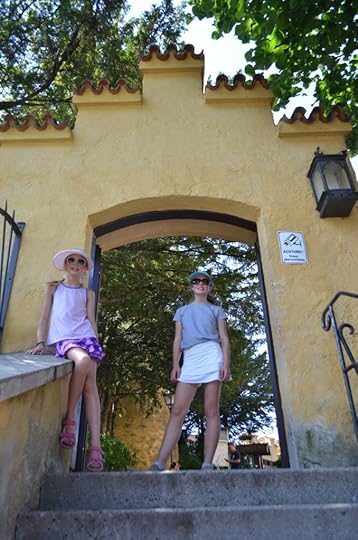


As you can see, the front entrance is far more familial and less imposing that the castle built by Maximillian’s son, Ludwig. The outdoor courtyard in the upper right, the view from the what’s essentially the deck to Nueschwanstein
Getting there
Since I already detailed the roads, parking and walk to Nueschwanstein, I’ll skip that part and go right to the castle. Just below the castle itself is another lot available for parking, and the lake which is not actually open to swimmers, but as the tour guide said, people come (not hundreds, but dozens) and use the shoreline. No one will get fined or arrested, but it does worry the locals and tourists, because they are increasingly trying to lure the swans in and feed them. This year, the mating pair only had a single duckling, and a tourist from China was caught trying to kick it to take a selfie. Pictures were taken and she was escorted off premises. Word to the not-so-wise: don’t kick the swans.
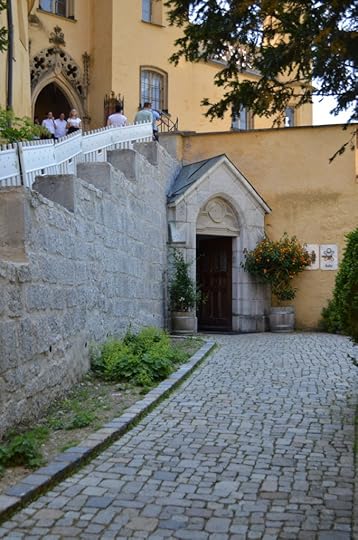
The “back entrance” for servants, as their building is adjacent to this (not pictured)
If you are walking up from the ticket office, or down from Nueschwanstein, it’s only another 10 minutes up another pathway, this one much narrower but still paved. It’s shaded as well, and not a big deal. The first building you see is the chapel, which from the outside looks more like a hothouse. Then up to the main house, which consists of two buildings, one for the servants, storage, carriages and the like, and the other is the primary residence.
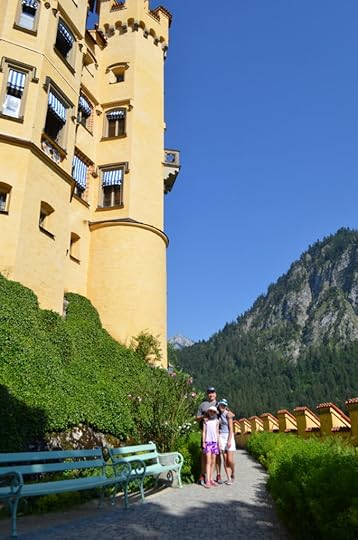
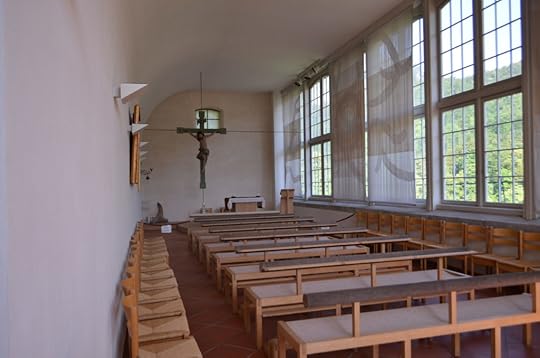
This castle is what I’d describe as a “family castle” where it was actually used like a home–or rather a nice, summer retreat. And since you don’t want to leave for church, just have your own on site.
The tour
For $28 Euro, two adults and two children receive audio-guided tours. You have an actual tour guide, which controls the flow of 20 people through the 35-minute session, ensuring you stay together, don’t take any pictures or items, although that would be hard, since everything is behind glass barriers. The rooms are cool, since each room has windows that have been left open; and the views are awe-inspiring. Built on the top of the mountain, the castle has 360-degree views of lake, mountains and valley. The Queen Marie (formerly of Prussia) had an entire floor to herself, including music, writing, waiting and bedrooms, each looking out to different parts of the territory. Just above her on the top floor is the King’s quarters. In his room, he had two secret doors with painted murals, one for the bathroom and the other for his stairs leading down to his wife’s bedroom. Love those sneaky doors.

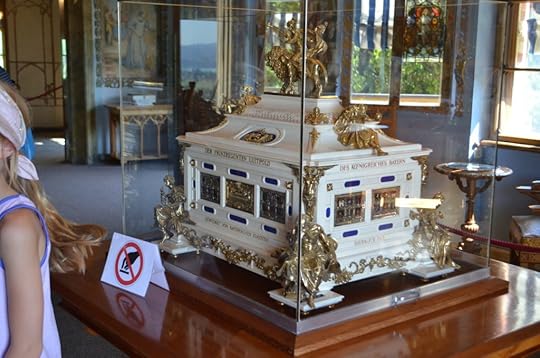
The shield on the left was a wedding gift made of solid silver, each of the small square pieces represents the coat of arms of a wealthy family who contributed to its creation. Behind it is an ax and a sword (yes, you could touch it). To the right was a gift to Maximillian for his 80th birthday. The corners are bronze, the blue is lapiz and what you can’t see are detailed monograms made of diamonds.
The other area open for the tour is the main entryway, the reception and dining areas, as well as the what would be considered the main entertaining areas on either side of the dining hall. The unique factor of this castle is much that every wall has original, mural paintings on every wall, capturing and depicting the history of the people, the rulers and the culture significance of the area. Gold leaf is everything, it too is authentic and original. The Bavarian guides are people are rightly proud of the respect shown this castle, and its significance. We appreciated the piano made of walnut given to the Queen when she was fifteen by her parents (in her music room) and the contrast of the one made and used by the King upstairs in his bedroom (hers was nicer/more refined).

Swans everywhere! This time in the garden overlooking the lake beyond.
The town of Fussen
Below both castles is the town of Fussen, which offers a ton of hotels, but not in the traditional, American style. Most are rather hidden, are unassuming and all unique to this culture. You won’t find a single, big-name, brand hotel in the area, which is a good thing. In fact, the hotels are considered historical sites, and signs posted along the roadways show a “hotel tour” so tourists can go visit each and every one. After finished our visits, we were game, and thought, why not? After four, we stopped, but only because we were starving and needed to eat and drive the @2 hrs back home. The ones we saw were lovely (and no, I didn’t take pics. I only have so much time/blog space).

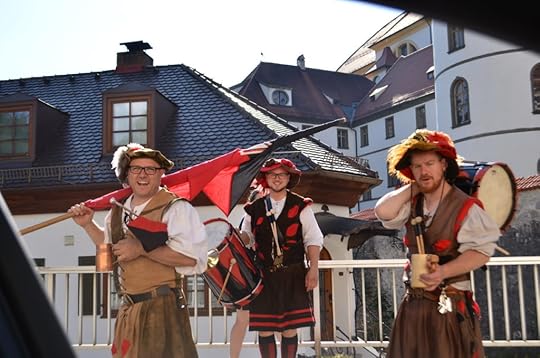

The town is lovely, quaint and also offers Fusseen Castle, but this is a completely different style. My camera battery died (shame on me) so I only got a couple of pics.

A singular pic before my camera croaked, but it the rest of it was much more majestic, although in no way comparable to either of the other two castles- this is much more basic, at least from the outside.
What I liked
The situation of the castle, the views from every window, its ornate and detailed characteristics, and the outdoors, which are incomparably nicer than Nueschwanstein. You can tell this was more of a family castle, because it has gardens, fountains, sitting areas and touches completely lacking at the grand Nueschwanstein. That’s what I’d call a man’s castle. In fact, this castle was simply deserted by comparison.

Fussen had a festival the weekend we went, which really meant more food for us!


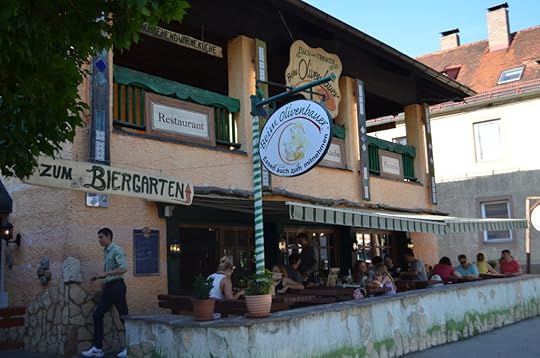
Another day, another million calories consumed. What you don’t see is the actual “garden” in the back, past the people on the upper left. As with most beer gardens, it’s a tree-covered area where people drink beer. Rog is always incensed that sparkling water is $6 Euros a bottle, whereas a beer is about a single Euro. Porsche asked politely if he would rather she took up drinking to save him money. Snap.
What I disliked
Nothing. It was all good! The path up, the tour (size, length, tenor and information) were great. Of course, we all want to see more—which would have included the downstairs of the castle, and the other building, but life is life. Castle operations are a business, and with the volume of people and tours, I’ll have to reach another level in this life to get the private, see-it-all view.
Recommendation
Absolutely do this tour if you are a history buff. Like
Nueschwanstein, walking the grounds is free of charge, but the inside is not to
be missed.
June 30, 2019
Nueschwanstien : Also known as Cinderella’s Castle
Today’s castle-going journey is being split in to two separate blogs because I have too many photos, and suspect WordPress will collapse on me, which happens when I push it, which means Castle Nueschwanstien in one and Hohenschwangau (Hohen is Castle) in another.
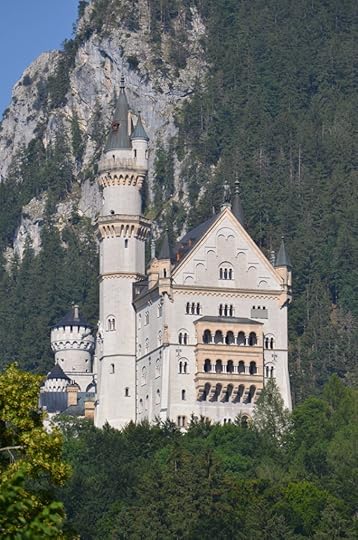
A clear shot from the paved road up, where you can walk, or have a horse-drawn carriage (like Cinderella, actually, but without the slippers).
Thanks mom
The shout-out to my 79 mom is important because it was she
who gifted me a calendar of castles when I was twelve. On the cover was Schloss
(Castle) Nueschwanstien, which seared itself in my mind as the end-all-be-all
of castles, and places to visit. For years, I promised myself that when I “arrived”,
I’d go. Little did I know it would take me decades to arrive! In truth, it wasn’t
that I couldn’t have gone before. It was just a tad out of the way when I’d go
to Berlin, Hamburg or Hannover for business and later, with Rog and the girls, heading
to southern Germany never made the top five on our list. Today, we realized
that we were a lot closer than we realized, which made our visit that much more…how
shall I say, impactful (embarrassing would be another word). We shouldn’t have
waited.
Fun fact: this castle is conventionally known as “The Cinderella Castle,” because Walt Disney famously said he modeled the castle the animated movie on Nueschwanstien.

Cinderella lives, just like Elvis
Getting there
We were north about 90 minutes, the drive was fast, per usual, the traffic nil, despite us learning it was the weekend of a fair in the nearest town of Fussen. As a side note, we later learned the family history of the three castles I mentioned, and it was sort of “I’m going to out-do-you” mentality, regardless of the fact the parties were related. That made it all the more interesting.



An incredibly beautiful journey to the region, the town just outside Fussen and a pic of the mountains as we head to our destination.
The closest major town is Munich, but it’s not too far from
Lichtenstein and Switzerland. On the Autobahn, time is always cut in half, so
that’s something to keep in mind.
Arrival and parking was a breeze. Straight off the freeway about five minutes, in town, parking nearest the castle is to the right, with a sign identifying it was full, so we turned left, took a ticket and parked, front row. Tip: make sure you have 7 Euro in coins with you because they don’t take credit cards for parking and this can’t be purchased on line (we didn’t know this).
Tickets and prices
A short walk of five minutes to the one and only ticket
counter, and another $28 Euro for two adults, as kids are free (at least 13 and
under). Because we arrived at 2, our choices were limited for tours; either the
Nueschwanstien or the Hohenschwangau Castle, but we couldn’t
do both. We asked the ticket agent for his insight, and he balked. My husband,
ever the man, leaned in, and asked, “if it were you, and it was your money,
what would you do?” At this, the agent glanced around and told us the skinny.
“Take the Hohenschwangau,” he answered in a low voice. “The Nueschwanstien tour has 60
people for a 20-minute tour, and it’s so crowded you will hate it. The Hohenschwangau
is limited to 20 people and a 35-minute tour, and it’s much better preserved.”
That was it. The translators are available in multiple languages, the most important being Mandarin from the number of visitors predominantly from China.
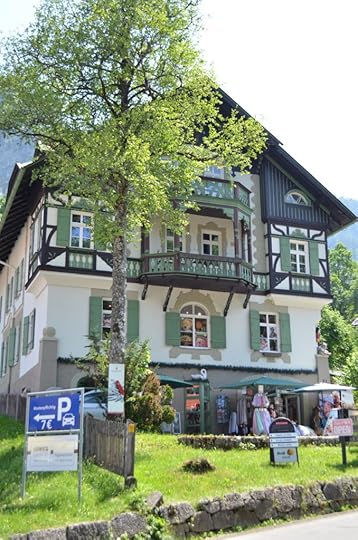


The view from the lot is top right and below, while the upper left is the building adjacent from the ticket office (which wasn’t nearly as pretty).
The journey up
Our time was in fact, very limited, because we were told the walk
up to the world-famous castle of my dreams, Nueschwanstien, would take
30 minutes, unless we were going to take the horse-drawn carriage. None of that
for us. Then we’d take some pictures around the external premises and inside
courtyards, because it is open and free to the public. Only the tours charge a
fee. We’d then have to go down, and walk back up the other hillside to Hohenschwangau.
Fortunately, the only sun on the way up is right at the base of the hill, the rest of the rather steep road is paved and in the shade. One shortcut on dirt stairs is available, and we watched an American couple and friend hand carry their stroller (with two kids) up the stairs—hundreds of feet. We were impressed.
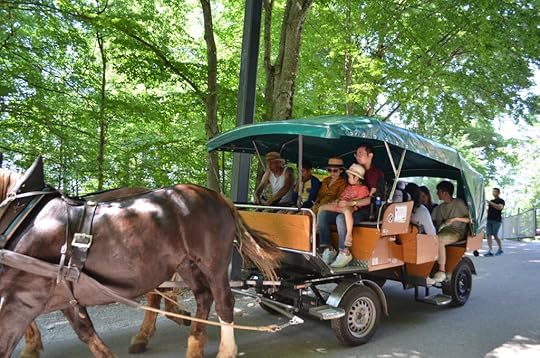


By foot or carriage, the scenery is stunning
Sitting on the top step was a man drinking his bottle. He was in good spirits, inviting us to sit by him, but we thanked him and continued; stopping was not an option. I was going to reach that darn calendar destination!
Halfway up is a rest station, consisting of two restaurants and an ice cream station. Sweating profusely, we continued up, reaching the top in another 10 minutes. Once at the castle, you can turn left or right. Left will take you up and around an side of the castle that’s being restored; the west-facing side towards the valley and lake beyond. Then you read the massive entry doors, walk in (again, all of this is free). You can take pictures in the courtyard, or continue up another set of stairs which takes you to the “real” main square. This area reminds me of Robin Hood, where the King walks out on the deck to great the crowds, but without the king.
The first thing you see from the base of the castle.
Back down the stairs you go, and those taking the tour look to the electronic sign identifying the next group. Through the turnstiles you go. The rest of us walk down, then back around the other side of the castle. It does have an overhanging, metal grate with invisible decking for pictures to the east, overlooking the rushing river below. It was freaky and awesome at the same time, and I thought I was going to get crushed by the onslaught of foreigners with selfie sticks, all battling for the corner spot. And I thought us Americans were bad!

The main castle entrance
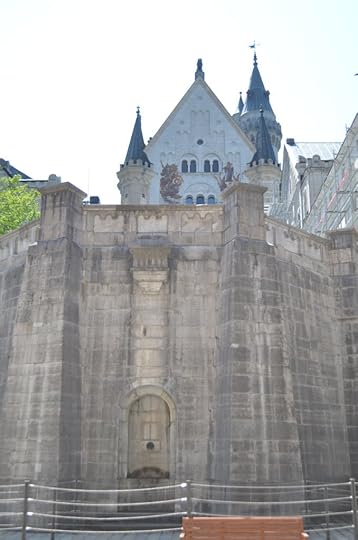
The “bottom” entry courtyard, which requires one to walk left, and up the stone stairway to the courtyard

The main courtyard on one side….

And turning around is this opposite facing…all the views are to the valley

What I liked most
The castle is all I imagined it to be and more. In both this castle and Hohenschwangau, the artifacts are original, not replicas. If you’ve not been to lots of castles (we’ve visited 15 or so thus far), it might surprise you to learn that most everything inside is a replica, because the value is high, as is the risk of damage or theft. It’s just fun seeing all the gifts from other royalty and such, knowing they are the real deal.
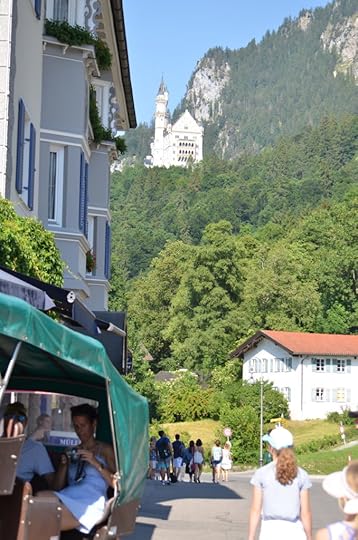
Coming down from the castle…
And least….
Nothing that can be changed. It was disappointing to hear from the staff that it’s overcrowded, the tours so big and fast—but even this I have to defend a bit. We learned more from the staff that tourists had taken too many liberties with the original items—from silverware to lamps, coats of arms, porcelain etc., and event destroying items on the wall. For that reason, about 90% of Nueschwanstien is closed off. What a bummer, but it proves the sad saying true: the actions of the few destroy it for the many. GRRR
Recommendation
Absolutely. It’s a feat of mankind for a person to have a vision for a castle perched on a hillside as well as the fortitude and engineers to design and construct the structure.
Feature picture: taking on site!
Legoland Germany
When our attorney said he’d used his one vacation in four years to hit Legoland in California, we were skeptical. Yes, we loved Legos as a kid, but nothing like our second daughter, who sits for ours bringing to life imaginary worlds and peoples. Still, we were unsure until Rog informed me the first rental he’d chosen in Germany is 6 minutes away from Legoland Deutschland. It’s also close to Stuttgart and Frankfurt, so the average tourist to Germany doesn’t really have an excuse not to go!
Today, we arrived at noon, fearing the worst of crowds. As you can see, it was basically empty. The car lot wasn’t even half full, only one of the seven, entry booths were open, and once inside, the lines were about ten minutes long—if there was a line. Message to you: if you are ever going to travel to Europe, go in June or July, as we have done the last few times. August is high season, not early July.


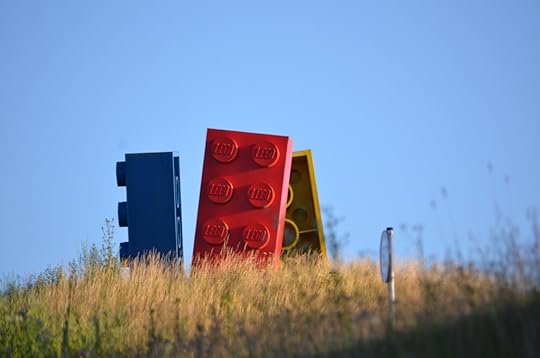

Have you ever seen a happier sign?? From the exit, you see these 2-story high legos jutting from the hill. I want one on my hill as an ode to my childhood.
Fluency
As we walked around, we heard at least a dozen languages. All the signs and communication are in German and English, but the staff goes back in forth in about six (we periodically asked the staff). While my basic German is improving, my accent is laughable—and yes, they laugh at/with me.

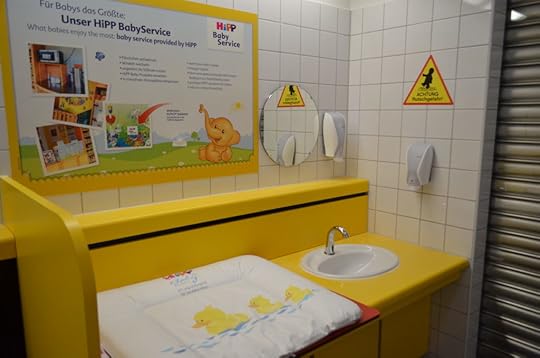
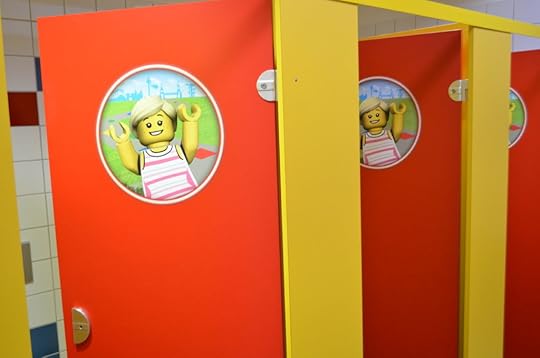
Everyone needs a picture with a life-size adopted Lego family, and have you ever seen a happier bathroom? In fact, everything is joyful and triumphant in Legoland, including the music pumped out around the park.
Size and rides
Two, moderately adult roller coaster rides exist, and I use that phrase because the thrill is intense but short, the rides about 1 minute after the initial journey, in one case, through a Lego castle—which I took a video and it’s on my Instagram feed. The waterlog ride is fun, and cameras are everywhere, so beware or you’ll get scolded like Rog did, when he took out his Wi phone, and immediately, a woman’s voice came over a loudspeaker in the middle of the river and told him to put it away (in German). The other locals on the log ride with us laughed, and he got the message. He put it away.
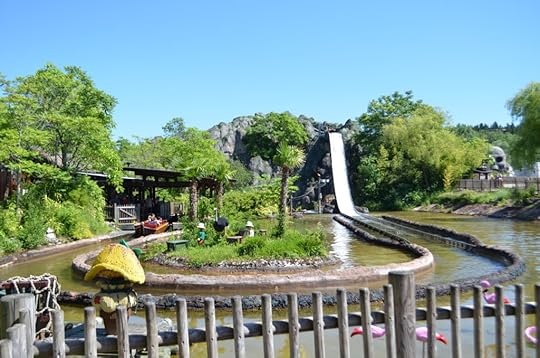


One great design of this park is that the designers constructed massive shaded areas for long lines. In the case of the rollercoaster, the lines snake through a mini lego castle, which really isn’t that mini!
The park isn’t massive, is well shaded and laid out, the three gift shops mixed between sections—think Safari, Aquarium, Egypt, China etc. I’d say the predominant rides and attractions are for age 6 and under, which makes sense, but that didn’t preclude the adults from loving or going on the rides where they’d fit (leg length is an issue). On the log ride, I needed to switch with Rog, even though he was boiling and it was his turn to sit in the front with a child, because his legs were too long and didn’t fit.


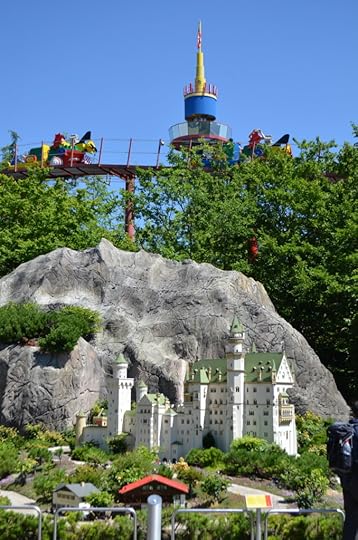
The line for the second rollercoaster was non-existent. Every ride has an real-time visual of the wait based upon where you are in line so you can make a decision if you want to continue waiting or bail. Love a choice! The bottom lego castle is where we go tomorrow!
Food etc.
Great fair all over the park, and actually rather inexpensive. The dollar is strong right now against the Euro, and everywhere we go, the quantities are overly large (e.g. we can’t finish a single plate), so I’ve taken to not ordering more than an app or salad, and taking bites from everyone else.

My favorite replica. Enormous, intricate and tens of thousands of lego pieces comprise this football stadium.
Cost
For our family of two adults and two kids (in Europe, they have a middle-range, teen cost), it was $185 with parking fees of $6. Both were less than had we shown up at the park, because we purchased on line that morning. A veritable bargain compared to Disneyland, but then again, the size is fractional.



What I liked
My favorite part/area was the cities built by Legos. It was a lot like mini-Europe in Brussels, but because these mini-city replicas were constructed of Legos, it was much more impressive to me. To this I’d add the life-size giraffes and elephants—can you even calculate the cost of that? Both girls liked the dragon roller coaster where she screamed the entire time as I laughed. Oh! The gift shops were insane—they have soooo many more projects than are available even on-line it was silly. Rog’s fav? A Bugatti race car with a working engine for about $300. You should have seen the men drooling over this endcap shelf.



What I disliked
Nothing! It was all good, and the lack of crowds divine.
Definite, absolute recommendation to go with kids.
Feature photo: taken at the entrance
June 29, 2019
Dinner and a dog attack
One of the iconic lines from Bill and Ted’s Excellent
Adventure is: “Strange things are afoot at the Circle-K,” said in the driest of
tones by an observantly sarcastic Bill (Keanu Reeves).
So it was that our day ended with the dog attack as we were having schnitzel, and because it’s on my mind, I’m writing about it first. (Blog on Legoland, which was this same day, will be up next).
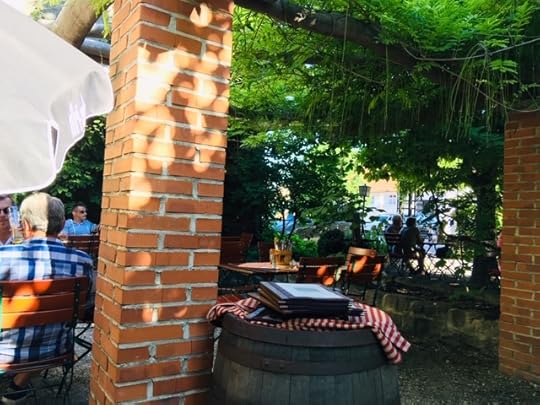
Under the protective shade is the other half of the outdoor dining space of the Gasthaus Adler in the Holzheim area of upper Bavaria
We’d tried to go the night before, but it was closed due to the food fair in nearby Gunzburg. Tonight, we were on a mission, being hot, hungry and tired from Legoland Germany. The Gasthaus Adler Sudtiroler Speckstube, is a two-story, hundred-year-old building with an outdoor seating area located under three enormous trees, and a second vine-covered area. On the other side of a gazebo is a wooden playground area for kids, and on the other side is a pasture where the dairy comes in fresh, turned into cheeses and other livestock turns into the food that we were served. It’s about as farm-to-table fresh as one could get.
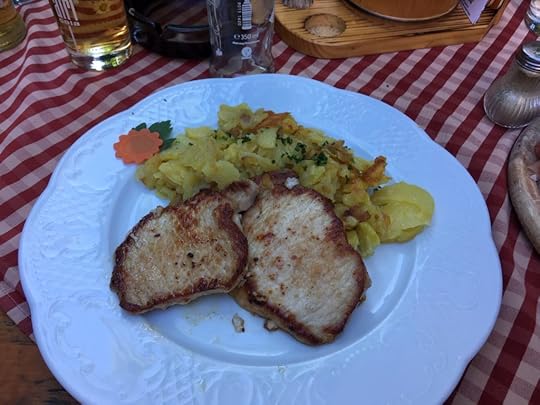
Traditional schnitzel with potatoes and mushroom cream sauce
We were effectively using our Google translate when the manager of 20 years took pity on us, and with a smile, spoke enough English we could order. Of course, all we wanted was schnitzel, but when she started to provide options, I was in. That mean asparagus soup, a meat platter of sausage, prosciutto plus a few other things I can’t recall but devoured. I’ll skip over the rest, and jump right to the part where we were eating, and a lab-looking like dog, who had been lazily sleeping under his parents’ feet (man, woman and 7 yr. old boy the whole time), jumped up and attacked a grandma who was making her way under the gazebo.
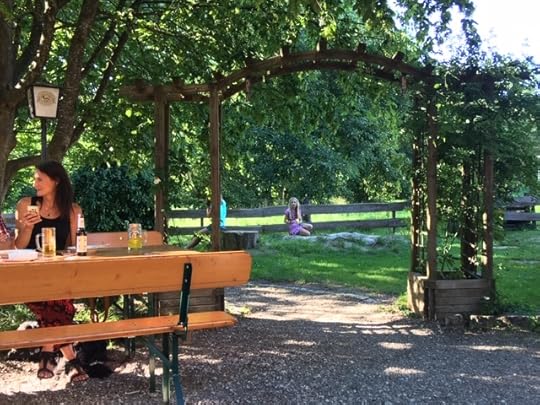
The gazebo where this all went down, and you can spot the dog lounging under his mom’s feet.
With my mouth full of pickle, I about choked as the dog lunched, bit her arm, paws on her stomach, knocked her right over on her hip as she screamed, and kept after her before Rog, the owner or anyone else could stop it! The owner was closest and first, dragging the dog off, while the woman, whom I guessed about 80, was seizuring on the ground. The entire area, which was full of diners, simply watched. No gasps, no shaking of head, just a slight downturn of noise. The woman’s daughter came quickly, the dog’s owner smacked the animal’s head and sat town. In the meantime, the diners started eating, the chatting picked up and the injured woman was led out of the area.
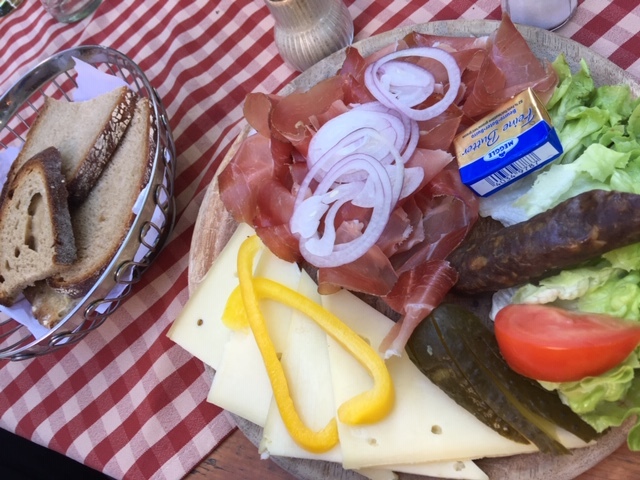

Farm fresh prosciutto, cheese and sausage with an equally divine, thin-crust pizza
We pondered the incident, more intrigued by the non-chalance we observed. If this had happened in the States, well, the cops would have been called, someone arrested or a do-gooder might have just shot the animal. Not here. These folks have clearly seen it all, and been through enough to not worry about a dog. Shortly thereafter, the medics came, along with the doctor and the woman was taken away. Not before, however, the mother of the dog returned from where ever she was (presumably the bathroom) and promptly freaked out. She tracked down the injured woman, the daughter and was profuse in her response-which we couldn’t understand a word, by the way.
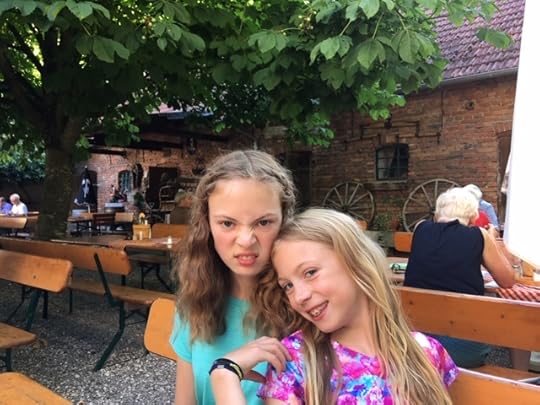
My 13-year old expressing her unhappiness at being asked to not drink her apple juice for a pico-second. The carriage house (cook house) behind her. ah. motherhood.
When we’d eaten our meal and completed the bill, we asked
the manager if the woman was alright. She expressed all would be well, but that
the dog was protecting the young boy, who was on the other side of the gazebo.
“Without it’s protector—the mom,” explained the manager, “the
dog was only doing it’s duty as a protector of the child.” Those within hearing
distance seemed to agree, and we thought about that after we left. It wasn’t
the dog’s fault, in other words, it was being a dog. It wasn’t the injured
woman’s fault either, she just happened to get between protector and child.
“In twenty-years,” she continued, “I’ve never witnessed such a thing.” Well, neither had we. All in a day in a foreign country.
Feature image: the back of the restaurant.
Two (Overlooked) Castles in Upper Bavaria: Burg Berghuasen and Saffig
Ok. Maybe a word. Hello. that’s what we got and we were thankful for it. The rest of the time, we used Google Translate and smiled a lot.
Day two/37 amounted to three hundred miles , two castles, a butcher-bakery, finding our rental and trying to make an honest Bavarian food fair. Disappointment faded with the people, service and incredible cuisine however, and we ended the day at midnight, while I stayed up until 3 a.m. converting photos and writing blogs. ha.
No speed limits: everyone loves the Autobahn
Shooting down the Autobahn, where no speed limit exists, is the real reason we came to Europe, or so I teased him. He experienced nirvana for about 300 miles and I didn’t blink an eye. 100 mph are normal, and we were getting passed at 110. I won’t tell you how fast he got that Audi A6 touring mobile going as I want my mother alive and happy, not angry or dead.

Zipping through the mountains, we see this incredible (put perfectly normal) feat of German engineering–this unbelievable bridge connecting two mountains, and why? Because why go twenty miles around when that can be shortened to about 2, that’s why. No stopping allowed, so I did my best between trees going way-to-fast.
German roads are ‘da-bomb’ as my daughter said, and we made good time from Aachen through the countryside to our first stop at Burg Berghausen Castle in Keppen in upper Bavaria. This is a manor that didn’t even show up on Wikipedia or any other searches pre-trip, but our car (and Audi A6 touring sedan) showed it on our dashboard, we were going right by anyway, so thought, why not?

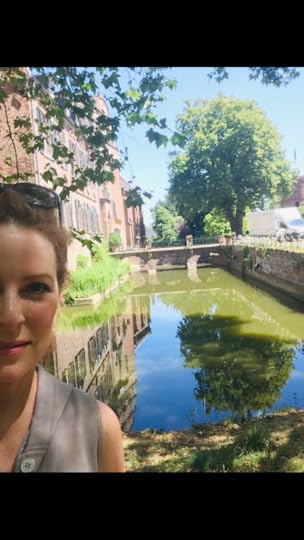

Each experience we created this day is special. The soaring tree which made us stop and say: God created this. The second was me thinking: I may need to write a book about a person inheriting a castle, and the last shot, with the girls, was taking as we hypothesized what the evening was going to be like for the couple getting married this evening, and the reception to be held on the deck behind us. What a night it will be for that couple.
It’s more of a manor than castle, but rightly got the designation because it has a bridge with a moat and lake at the backside. Across from the main building are large stables, servants quarters and substantial armory at the front entrance. It’s privately held, open only for special events, but walking the lawns and parks around is open and free. Muskrats the size of a small dog ate feet away from us, and a whole family of four (parents and little ones) waddled right on up expecting to be fed, as did the single, large swan in the lake and loads of ducks. The visit was short but impactful, with Rog and the girls identifying the muskrats and hundred-foot beech trees being their favorite parts.


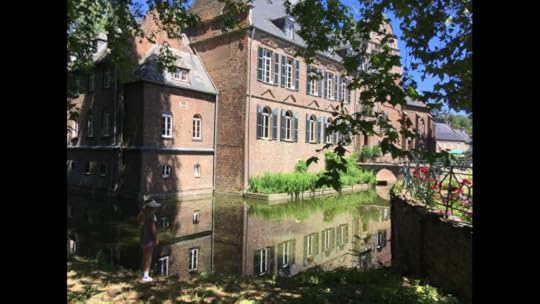
The horse stables, side of the castle and another angle of the front



The world’s largest, tame muskrat, swan and servants quarters
Local eats in Keppen
Despite the luxurious foods offered at the rest stops, we wanted real German delicacies. Not two minutes in to town we found it at the town’s one and only butchery/bakery. Potato salad, the likes only found in my mother’s kitchen went hand in hand with marzipan and almond pastries, as well as sausage and cold cuts. It was sweet and salty, just the way I like it—so much that I took a pic of the mother-of-all bread making stoves and cajoled the owner to take a selfie. Her first ever. She was so embarrassed, she was fussing over her hair and giggling like a schoolgirl the entire time.



Today, Rog had his vehicular nirvana while mine was culinary. The marzipan pastry as long as Rog’s hand and the little town of Keppen. This was 5 pm-ish. Rush hour.
A note on Keppen: every person here has been incredibly
kind and polite, but speak functional English (hello) at best. We have not met a single person (in two days)
who speaks conversational English, although we have two more days so things may
change. I’ll keep you posted!
About ten minutes later, we were in Saffig, going up a dirt road to visit the local castle, which is only named Saffig Castle, another one that showed up on our Audio roadmap but not on Google or any listing anywhere! This castle is seriously old (13th century) and is undergoing complete restoration. Personally, I like the old, original stone, and we weren’t allowed to take any photos. Side note: we get that a lot, but usually ignore it, because it’s a ploy to get us to purchase stock photography. Yet sometimes, I ask for permission and get the wink and nod, thus allaying my guilt. That’s what happened with Castle Burg, but not here. I actually received a scowl instead of the nod, so I dutifully put away my camera, but did manage a single shot through the trees as we left the area.

My off-premises shot through the trees. See what I’m talking about on the restoration above? It looks fake and call me a traditionalist, but I like the original.
Our Bavarian rental
This time around, we wanted the fully country experience, which included cows, farmland, locals and meeting more German folks. We loved and appreciated going to towns where English wasn’t spoken at all, because it forced us to speak the language (or at least use Google Translate). Our desire came true with a home in Kammeltal, (pronounced like Camel-tall). From VRBO, we found the home, and are presently perched on the top floor of a two-story home, with three bedrooms, two baths, two balcony’s and modern kitchen, with views to overlooking the small town on one side, and farmland on the other. The backyard is grass, a trampoline and hothouse garden, all for our use. Check in time was 9, and we arrived at 8:40. It’s light here until 10:30, just like Coeur d’Alene. Our German hostess/owner and her family live below us, but we’ve only had a single sighting, which I expect will continue. The house, street and neighborhood are local, mostly older folks who ride their bikes the few blocks in to town—which is a completely different look, feel and style from Ashford, and that’s what we love. One day and veritable world away from what we experienced the day prior.
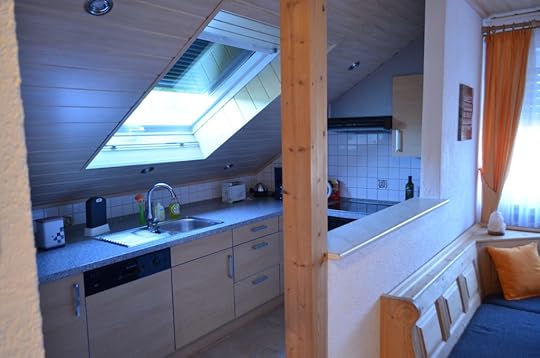



A few shots of our authentic Bavarian home

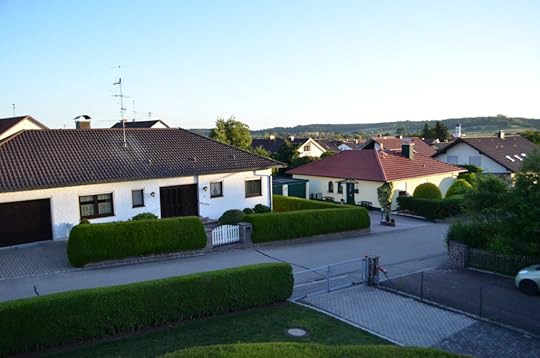

Baby room, front and back yard
What I love
People walk their dogs through farmland, which means strips of gravel separating wheat and corn fields, instead of paved paths alongside freeways or streets.
What I don’t
Only four restaurants exist that only has its name listed, without
any other details. But the 4 km drive in one direction gives us one town, a 6
km drive in another direction gave us Gunzburg, and that’s where we went for
dinner.
Even before we knew that all four restaurants closed Friday night at 8 p.m. in Kammeltall, we were intending on hitting the food festival. Sadly, we missed that too! Yet the (slightly larger) town of Gunzburg has a much bigger Old-town/downtown (because a new/modern area doesn’t exist as of today). Fun fact: Gunzurg was founded in 70 b.c., although it does look slightly more updated. It features its own main square, where we found Greek, German and lots of outdoor pubs but after 9, only serve appetizers and drinks. Fortunately, one superb Italian restaurant is open until 11, and we were seated by the owner, referred to as “Uncle.” Love that. Pure Italian through and through, but has lived in Germany for 30 years. I’ll let the pictures do the talking, but suffice it to say we want to go back to Guntia again before we leave, eventho we will be in Italy for 5 days in another week.



Our dining experience in Gunburg was tops, the freshly made mozzarella caprese my favorite



Daughter number 1 passing out on #2’s lap, who then enjoys sparkling water at the white table clothe experience of Guntia
Feature photo: Burg Berghausen Castle
June 28, 2019
Ashford, Kent
From Manchester, through Eton and Windsor Castle, eating with the locals and preparing for the Channel Train
We’d traveled down from Manchester, choosing Ashford as the
destination to spend the night, taking the channel train the following morning
at 6:55 am. Sometimes, the best laid plans go awry, and we’d not been in
Britain 24 hours when we learned that first hand, but I’ll get to that in a
moment.
Why Ashford? It was logical, pure and simple. We chose Manchester as the airport instead of Heathrow as a forcing function to see a bit of the countryside going down the country (think Leeds Castle, Windsor Castle in Slough) and the farmland. Because it has the EuroStar channel train, we planned to wake up, have breakfast at the B & B, drop off the car and walk to the terminal. On the return, it’s our intention to drive up the coast, wandering along the rocky shores, connecting with an author friend I met on Instagram and have now virtually known for four years.
Reality of driving from Manchester to Ashford
We had no clue about the traffic from Manchester all the way
down to London. Like the States, Britain chooses to use the summer months for
road construction. Instead of an easy four hours, it was more like a stop and
go six, slowing the pace of travel to 50 km per hour. It was torture for both rog
and myself, but cameras are everywhere, so we kept alongside the locals to be
safe.
So, we had pa-lenty of time to enjoy the cows, sheep and
other livestock dotting the lush, green countryside, my girls claiming they’ve
never smelled such a strong odor in their lives. Personally, I didn’t mind.
Nothing like being thrown back to memory of being on the Alberta farm where my
father grew up, in the youthful days of summer, when we thought digging in
cow-pies was fun and had no issue jumping in to the slow-moving, leach-ridden,
cow-trodden river that ran around the base of dad’s farmland.
Along with way, we stopped half a dozen times, each time
marveling at the rest-stops which are more akin to a nice park and a bit of San
Diego shopping mall experience rolled into one. I made and posted a short video
on Instagram with visuals, but think hardwood floors, curving leather and
modern couches, individual and group gathering areas under skylights have been
designed in the center of the building, with the shops on the outer rim.
As time grew short, we were in jeopardy of missing our check in time, making us take a rain check on Leeds Castle, but did do a swing by in Eton and the Slough area, which conjured images of my last visit. I spent a few days in the area, and in my free time, went for what I thought would be an easy run to Windsor Castle and back. I became woefully lost, ending up back at home in the near dark, but the next time, was determined to do better. Once again, I got myself lost. The saving grace was it ensured I saw (and re-saw) the old town, castle and backroad streets, searing the map in my mind, which helped us out.

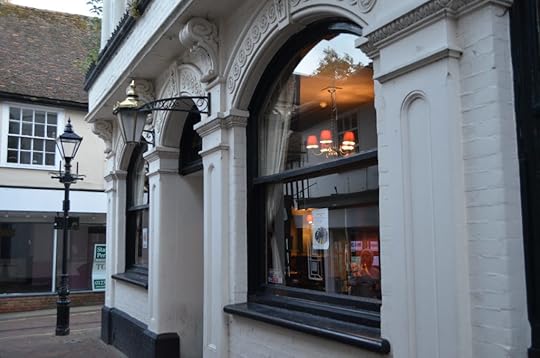

The charm of Ashford, all off High Street (and within two blocks of the B & B)
Back on the road, we hustled to Ashford, making it by eight p.m. Rog had selected a bed and breakfast two blocks from old town. The older neighborhood is quaint and traditional, red brick stand-alone homes with attached. While Rog took care of some business, me and girls grabbed the camera and wandered about the neighborhood. During an hour’s walk, we encountered two cats and a one man, standing on his front doorstep smoking.
First time Bed & Breakfast: Hayesbank B & B
The Haysebank Bed & Breakfast is on the corner the tree lined street heading in to town, the red brick, three story building with attached cottage offering 11 bedrooms. Gabriel, the proprietor, is German, a lovely man who helped Rog guide his car in the small, parking area behind the restored home. The rooms are quaint but tidy, the mattresses perfect and like most European rooms, lack sheets. Just a bottom sheet and a comforter. First-timers to Europe are usually quite distressed by this detail, but I don’t even think of it anymore. (Rog tells me to include these finer points in my blogs in the hopes they increase the actual usefulness of the piece. What are husbands for if not continual improvement?)
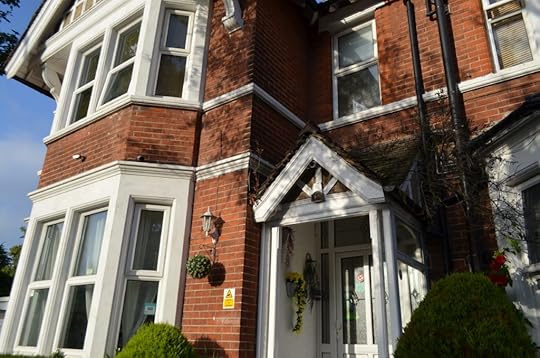


L to R: Haysebank B & B, which is on the corner of this street (upper right) and bottom is the neighborhood. Lovely, quaint, quiet, safe, and just two blocks from town.
For dinner, we walked about two blocks west, across a street
and under a portico we emerged to see Old Town, instantly transported to the 17th
century. The girls remarked the buildings looked original, and most certainly
the streets and narrow passages were intact and unchanged from the forefather’s
layout.
(As I’m typing this piece as we ride the Eurostar through France, on the way to Brussels, thinking I should be looking outside—so I stop, and we are going by so stinking fast, I wouldn’t be able to take a picture if I wanted to. Oh well!)
The question of food
We searched for “authentic English” food, and you know what? Other than pubs, which aren’t the places to take our girls, instead, we found were Arab, Indian, Chinese and Mediterranean cuisine. It was a culinary melting pot, exactly what Britain has become and is. After twenty minutes of wandering, we gave up, going back to the Mediterranean, which was mix of Greek with a splash of middle eastern.

This is High Street, in Old Town, Ashford, Kent. About half-way down is The Fountain Kabob.
We were expecting Switzerland prices and serving sizes, but it was more like the outrageous portions of the Cheesecake Factory for under thirty dollars. I couldn’t eat half my meal, nor could the girls, and even Rog was hard pressed to finish his lamb and pita. The three gentleman at the Fountain Kabob on High Street, a hole in the wall eatery on the main old town street (and only establishment with a neon sign) were lovely.
Happy and full, we wandered up and down High Street, then branching off on either direction, ending up at St. Mary’s Church. It was closed to visitors but the grounds were open, and we did a full circle of the 17th century house of worship. The grounds are small but well-kept, the wrought iron fencing original.



St. Mary’s Church: straight out of a Pride & Prejudice novel
A neighborhood rap party
In bed by around ten thirty (well, they were, I was up until
midnight), the breeze picked up, which was an answer to prayers, because it
became very muggy around seven. The downside was someone, somewhere, in one of
the local homes or flats, started blasting the UK version of Wiz Khalifa, LOUD.
Now, I’m good with some wanna-be Wiz, but not at 1 a.m. on a school night. Ears
ringing, windows rattling, the punctuated swear words like a rock hitting the
wall, increasing in strength that it finally woke up Rog and Porsche, who can
usually sleep through the zombie apocalypse. He mumbles for a bit, after at 2
a.m. rises and gives me warning: It’s coming.
Standing at the window, he shouts: “Are you kidding me? Can
you turn it down please? We are trying to sleep!” Imagine Rog, yelling at the
top of his lungs, waking the entire neighborhood as he seeks to quiet the
music. Porsche jolts up right in bed, I hold my breath, wondering if we are
going to have a incident far larger than the music itself, but the music turns shuts
off immediately. The street goes dead silent. At that point, Porsche starts to
mutter that on the scale of extreme, “Dad is a twelve,” she says. I start
giggling, because I thought Rog sounded like a madman. The people upstairs,
who’d been creaking around all night, also cease all movement. In fact, it
seemed as though even the air was afraid to move because Rog might go postal.
Porsche continued wisecracking, which kept me laughing and we were up another hour. Hence, last night, I actually fell asleep at 3 a.m. and was up a bit before five.
Ashford Train station and final tips
The drop off area for rental cars at the Ashford Eurostar
station is under construction, requiring a seriously out of the way drop off.
Avis’ directions were worthless, and we spent over an hour going back and forth
on a do-loop before it became clear we were going to miss the train through
France to Belgium then on to Germany. That was $700 Euro I was not about to
throw down the toilet.
“We are leaving the car in the lot,” I mandated, dropping the keys to security at the terminal and calling Avis. I hypothesized the price we may pay was far less than screwing up our entire itinerary. The great news is this: the attendant outside the Avis station (which was closed) willingly took the car keys, then the Eurostar manager (an equally pleasant gal) accepted our tickets, learned of our plight and sent a note to management, and in five minutes we were going through French customs just in time to be led to platform 4 for boarding. The girls thought it downright Harry Potter, the only difference being the bullet-like train speeding forth minutes after we made it to the platform.
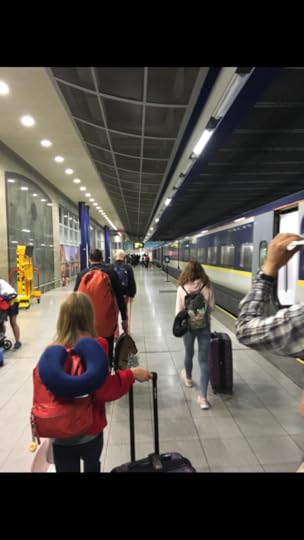
The march from the international train to the massive, city-like structure within Aachen, Germany. Marble walls, clean floors, quiet and sooth running, like most German things.
Another tip (while I’m thinking about it). We saved the money for the Ashford to Brussels leg of the trip, purchasing economy. It’s open seating (not assigned) and we lucked out with the girls getting two seats together. Me and Rog are spread out, but his mate is working and mine is sleeping, most of the occupants (as I surreptitiously glance around) are professionals heading to the city, and a few mid-twenties men clearly way too spry for this time of the morning. Quiet and comfortable, even economy is a great experience, no food or wi-fi, but plug-ins galore. The next leg is business class, assigned seating with tables and I’m hoping for a few photo opps.
Am I working at all??
For five of the nine-hour flight from Seattle to Manchester, I wrote the framework for two new books. I felt like a prisoner released on parole, because three months ago, Rog mandated I not start outlining or work on a new book, but focus on the family and travel blogs. Needless to say, the dam burst forth, but I’m telling you what. Like an explosion of water, what erupted from my mind was messy! After being out of it for that long, it felt as though my desire was cruising along in fifth but my car was struggling between first and second. It may turn out what I wrote ends up in the garbage, and that’s ok. At least I was able to get back to it, and it felt good.
Feature Image: off High Street in Ashford, an original building now housing an Indian food restaurant. A completely modern day representation of old and new worlds unified.
June 23, 2019
The Divinity of the Duomo Cathedral
What would take us away from sunny Lake Como south to Milan? The Duomo Cathedral truly one of the most magnificent churches ever built. The construction required thousands of skilling craftsman, each specialized in their own trade, passing along their expertise and tribal knowledge through generations of time. After hundreds of years and plenty of archbishops, the Duomo stands as a testament to the ingenuity and sheer determination.

A view from the main worship area within the cathedral
The journey & parking
Milan, (or Milano, as the locals and country signs call it) is a city of approximately four million. The drive from Como took approximately four hours. Having never had our own car in Milan before, we were initially hesitant, then had a moment of clarity. We drive all over the place, from Los Angeles to New York, Berlin to Boston, which are far larger. Milan proved to be a piece of cake. Straight in we went, found street parking for a few bucks, and even got a caprese appetizer on a side street before walking a few blocks to the cathedral.
We arrived to find a part of the cathedral under reconstruction, and a whole lot of military personnel protecting the national landmark. Neither bother nor obstructed us whatsoever. The main square was less than half-full, the day overcast and cool. In other words, a perfect day to visit.
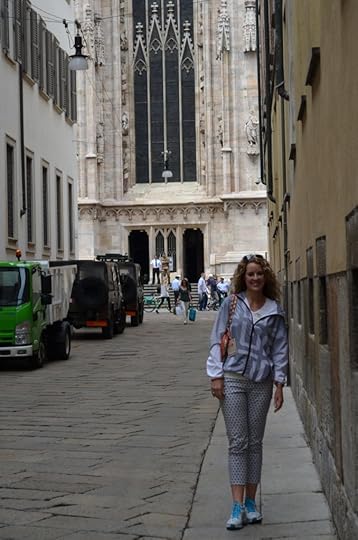
Every entrance is guarded (as you can see behind me) and parking on some of the closets streets is only for service or military vehicles
The fees and expectations
If you want to take your own photos, an extra charge of $5 is required, but completely worth it. The columns, stained glass windows, and 15,800 pipe organ make it worth the money. Because it was a slow day, the inside wasn’t crowded in the slightest, which was a good thing; the mausoleums holding the deceased archbishops were worth snapping a photo, which we did multiple times.

Street parking all around–this was a Thursday afternoon
The tourist information identifies which archbishop was responsible for a particular section of the Duomo, which shows the link between general manager, if you will, and what was created. Imagine the vision of these guys, who knew their contribution was vital, but they’d never see the completed work in their lifetime—or for several lifetimes to come. Talk about commitment. Most of us can’t see a few years in front our faces, let alone decades or centuries.



My number one recommendation is don’t go when service is in session!
My mother plays the organ, so I’m a bit familiar with the instrument. The long, metal rods scaling up from the balconies make it the largest organ in Italy, and in the top 15 instruments in the world.
Beyond the cathedral
If churches, architecture or history isn’t your thing, don’t
despair. The Duomo Square has shopping area known as the Piazza Del Duomo.
Think the Mercedes Benz clothing/jewelry store and the like, along with multiple
outdoor eateries. If your traveling partner is at the Domo, you can easily
spend an hour wandering through the shops or taking in a hot, chocolate mousse drink
as I did (which was more like pudding, actually).
The entire visit will run you no more than two-four hours, depending on your tastes. That leaves a lot of time to explore other parts of the city.

Just one of many, many entrance doors
What I liked best
All if it, the area, the cathedral, shopping, eateries, you name it. I even got the military guards to smile and take a picture with me, and they accommodated!

What I liked least
Nothing. Nada. It was as perfect as the day could get.
Feature image: The Domo, taken from the main square
The best of Bellagio
“Are we going back to Bellagio?” is how Rog remembers asking
the question. My recollection is slightly different. I thought it was more akin
to “We are going back to Bellagio,” the statement said with a bit of force.
The town holds a singular point of divinity for Rog, which would similar to a devout Christian would think of the Garden of Eden being placed in your back yard. In other words, heaven on Earth. Nope, this isn’t the hotel in Las Vegas, Nevada mind you, but the slim peninsula situated on Lake Como.

The beauty of the Italian Alps–this was just a random stop at a persons home, and I couldn’t resist (they were polite and pleased I adored their home/view)
It’s all about the food
The similarity centers on food, the apple in one instance,
but meats, cheese, and yes, a few apples on this one. You see, by the time we arrived
in Bellagio, we were starved. We roamed the streets, getting in a few sites
before stopping at a restaurant situated half-way up a narrow allow, but wide enough
o allow a two-person table. We took the waiters recommendation, ordering what
we thought would be an appetizer-size plate. It turned out to similar in size
to a large pizza, the wooden plate laden with an assortment of cold cuts,
cheeses and fruits, fresh bread, crackers and all types of jams.
This was culinary nirvana for Rog: massive quantities of the authentic fair. So it is that we are taking the girls back this summer, his hope to find this exact eatery once again and replay the experience that made such an imprint. Shopping? Yeah, we did that, purchasing items for relatives at seriously discounted prices given the currency exchange. The ferry ride? Check. Walking the waterfront? Yep. Traipsing up and down the narrow streets, indulging in the local gelato? You betcha. But nothing…nothing ranks up there in Rog’s mind like that platter of food. Me? I was along for the ride, literally. I loved it all.

Narrow streets (this was actually one of the wider ones), no lane markers, the motorcylists racing between cars already packed like sardines in a can. This is where I got the idea to have one of my lead characters in the Danielle Grant series die while on his motorcycle. It’s real!
The journey, and I’m going to throw in Menaggio and a bit of the Lake itself
This day trip to Bellagio started out as a one-day itinerary
once we arrived in Lake Como. To the uninitiated, the locals, and Italians
spell the lake Como, pronouncing it “oh,” as in Lake “Coh-moe”, slightly
different that Americans, who tend to spell it “Cue—oh-moe”, and spell it with
a ‘u’. It doesn’t really matter, because the either way, it’s big, diverse and
takes a while to drive around.
From Zurich, we went over the Swiss Alps, using the road favored by touring bikers (motorcyclists) and the sports cars who thrive on the twisty-turvy road. Along the way, you encounter the Contra Dam, cows and a dramatic change of scenery (which I partially cover in my blog on those topics).

What we didn’t expect to see was such a dramatic change once we reached the top of the mountains, seeing the planted Italian flag. The differences were stark. The roads, just as twisty, were not as well maintained, so we had to be careful of the potholes and general condition, yet we were so captivated with the views and architecture of the hillside homes it didn’t matter. Mountain lakes like Lake Lugano were dark grey, the clouds giving the glossy covers a matte finished look. The roughly three-hour drive from Zurich ended when we hit the first down on Lake Cuomo, Menaggio.

The top of the mountain has a mother Mary statue for safe passage of travelers. I was safe but I was cold!
A plethora of towns
Unlike my adopted home town of Lake Coeur d’Alene, Idaho, which
is 22 miles long, and retains the name wherever you are actually located, Como has
townships dotting the shoreline. In the States, certain areas are named (Loffs
Bay, Mica Flats, etc.) but those are informal neighborhoods. On Como, each
township is just that: its own town, with a center, police force etc. We stayed
in Menaggio at the north
end, choosing a place right close to the tunnel for ease of access to what we’d
call a freeway, but is more like a narrow, two-lane road. We also desired a pool,
(thinking it was going to be hotter than it was), parking (hard to come by) walking
distance to the center of town and most of all, the ferry.
Menaggio offered all of that, but then we learned, so do many other little areas. This summer we decided to be closer to Bellagio and are staying on the opposite side of the lake in Verena, the ferry ride to Bellagio about five minutes, versus the fifteen from Menaggio.

The official marker in to Italy was anti-climactic. I wanted officers and a stamp (as I wrote in one of my novels) and I got crickets.
Hillside rentals
The relatively low prices of rentals on the lake are what astounds most folks (Americans) we speak with. I believe it’s because the impression is one of such exclusivity for the lake itself as the vacation spot for celebrities and the wealthy. The reality is the hills are full of vineyards cared for by the full-timers, and the price of top floor penthouse is less than $2,000 US for ten days, the private elevator, parking, three-bedroom, three-bathroom flat with five decks a bargain.

Top deck view, the tunnel to the North in the background. It was quiet however, barely a sound. The hill behind our flat were vineyards.





Back to Bellagio
The first time we visited Bellagio, we decided to drive, and it was a journey of about five hours all the way down and around the southern tip of the lake, then up to the peninsula. Nope, we had no idea it was going to take this long, but with only a single, extremely narrow road to navigate and a ton of stop lights, we made it as quickly as possible. Needless to say, we took the ferry on the return trip, and the journey was shortened by about 5 hours (it was only a fifteen-minute ride across the lake!)

The ferry schedule is every thirty minutes all day, docking portside to the center of town
Bellagio has two faces, really. The center of town, which is flat and lakeside. This is where quite a few of the major shopping takes place (think Hermes and the like). Yet dozens (hundreds?) of smaller boutiques with Italian goods dot the steep alleys that extend from the center up the hills. The majority are perhaps the size of my living room, crowded with silks of all types, jewelry, shoes or purses—the kind of things favored by women from out of town (me!). You’d think I would go crazy, but actually, I didn’t. I stopped after purchasing a few leather bracelets, because I’d seen quite a few of the same items in Lugano (another township) at a lower price—roughly 30%. I held my money and went back to Lugano to purchase a purse and a few other things, still enjoying the experience of Bellagio without feeling like an irresponsible shopper. To give you an example, a purse I’d seen in the US was $700. In Bellagio, that same purse was $500, which is quite a discount. In Lugano, it was $300. No that’s called savings.
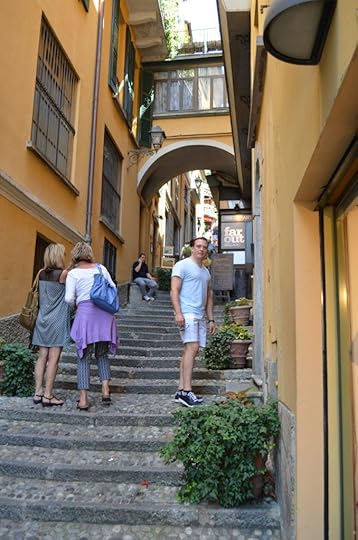
Steep, narrow walkways–this was one of the less traveled–others can be wall-to-wall people
The other face of Bellagio is just outside the center, within walking distance, and it’s what I’d call the local areas. Lovely, mostly empty beaches, gardens and what I’d call sitting areas—secluded spots with benches for sitting and watching the ducks on the water. We could only rationalize that those who come to this lake want to “be seen” at the hotspots either on a boat or on a packed beach, rather than enjoy the quiet and romance that’s actually available and free! So it was that we went exploring and, in an hour, counted four different waterside areas, all in the area of Bellagio, all as free of people as the next one. On several occasions, these public areas were right next to high-end hotels. Glancing through the trees separating hotel from the public area, we saw the pool area packed with sunbathers, the chairs right next to one another. It’s all a matter of preference, we surmised. If you want to come to the lake, sit poolside and be pampered, then you have plenty of options.

Lakeside pools offer slips for boats but also much warmer water than the glacier-fed lake
The waterfront
By now, you are probably sick of reading my commentary on “the waterfront” of whatever lake we’ve visited. Sorry, it’s going to continue. Upon reflection of my seeming obsession with waterfronts, perhaps it’s because they are all so different—country to country and town to town. Such care and attention is given to the trees, pathways and facilities, more than often I feel like I’m in some version of Cinderella’s castle and the ferry godmother is going to pop out and grant me a wish.
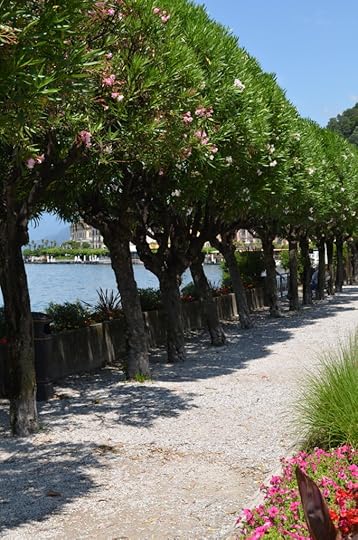
The lovely (and basically empty) pathway leading to the center of Bellagio
And on that note, don’t be afraid to drive that rental car to Lake Como or pick one up when you arrive. Parking is plentiful in the Lake and surrounding areas. Not all rental homes have parking, but many do, as well as the hotels.
What I liked best
Each township has its own vibe, culture, eateries and destinations to see. It’s no wonder people come for a month and spend days roaming the 146-kilometer areas. If you are bored and want to visit the celebrities, I found this guide just for you, which also gives you some options as to how to best get to the lake.

Up the hillside are villas and wineries
What I liked least
The driving! Whoa, never in our lives have we encountered the insanity of the one-way, narrow, basically lawless driving along the lakeshore, particularly between and within the smallest of the townships. Because we have gone at the beginning of the summer (June and to mid-July), instead of the high season, which is August, we didn’t even experience the worst of it, but what we did encounter was enough. Oh well, it’s part of the experience.
Feature image: taken from the deck of the flat
June 22, 2019
St. Moritz, crossing the Swiss Alps, Italy, oligarchs and cows
Today we spent the afternoon with an executive from a
research firm and his voice over actress wife. As we toured around the neighborhood,
the conversation eventually went to the subject of travel, and if my travels inspire
my novels, or was it the other way around: Did I get an idea of a destination and
then go there for the final research.
That led me Switzerland, which is off topic for my schedule
of blogs, but I’m pausing to cover two areas that I realized I’d completely
skipped over. The Swiss and Italian Alps, the “James Bond” Dam, handcrafted
homes perched on the hillsides, defying the natural laws of gravity, the homes
of the Russian oligarchs in St. Moritz, along with the painfully expensive
whole hazelnut chocolate bars and handmade clothes in town, and last but not
least, the cows. Yes, the cows, but I’ll get back to that.
Each and every one of those items found a mention in my books. For this piece, I’m mixing it up. Rather than give you the standard play-by-play route we took during this particular trip that served up the creative buffet, I’ll break it down in to the scenes I wrote. A fun change for me and perhaps more interesting for you.
Zurich
In a previous blog on the penthouse we rented, I mentioned the tree-lined streets along Lake Zurich, my fictitious, but not totally fictitious wealth management building. I witnessed a father in an overcoat, exiting a U-shaped building eerily similar to the Walldorf-Astoria in New York. He had a young boy and girl on either side, equally well-dressed.

The drive out of Zurich leads along the river, then up to the mountains, but this road was chock full of road bikers–and by that, I mean BMW touring bikes. Lots of them.
I thought to myself: he looks like a serious billionaire, and those are his fortunate offspring. It was the place a man like Lars Egle, one of the lead characters would live, and that’s where Danielle inadvertently runs in to Lars in the lobby near the end of Made for Me. The scene was exactly as I imagined, and it all came about watching that split-second interaction of the father and children. (I thought taking a pic was tacky, but more importantly, I couldn’t get my camera out fast enough and missed the pic).

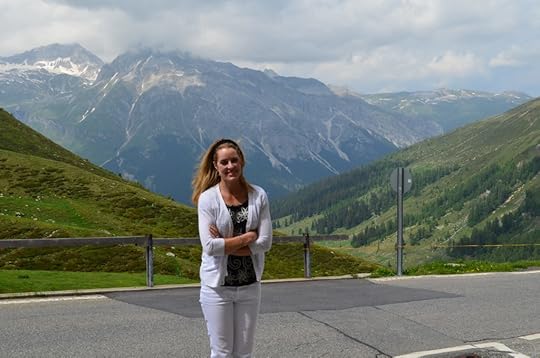
On the way up and it’s getting colder–but I refused to put on a coat until the very top
The cows
Leaving the city, driving alongside the river to the Alps
was another scene, this time with Andre, Danielle’s first love in Zurich (also
in Made
for Me). Escaping their struggle in their lives, they ride his motorcycle out
of town, going up the beautiful, windy hills, seeing the cows. The inspiration for
this was the very ride we took on our way to Milan, with a stop through to St.
Moritz. We ogled at the green river to our left which looked more like a
flowing glacier than river. The cows were so large and the fur seemingly so
soft, we stopped the car, got out, and approached. They had the massive,
old-school cowbells that I didn’t actually think existed outside the movies.
The fence was a flimsy little thing, which wouldn’t deter a thief whatsoever, and
the cow was completely unconcerned when I rubbed its head. Now, this may come
across as odd, but I’ve touched a lot of cow hide-it had been rough, not
smooth. This breed of Swiss cow was more like cashmere. I was so taken with the
entirety I mentioned in the book, along with a grove where Andre and Danielle
have a romantic interlude.
Yeah. The cows inspired that—and I really love that scene.
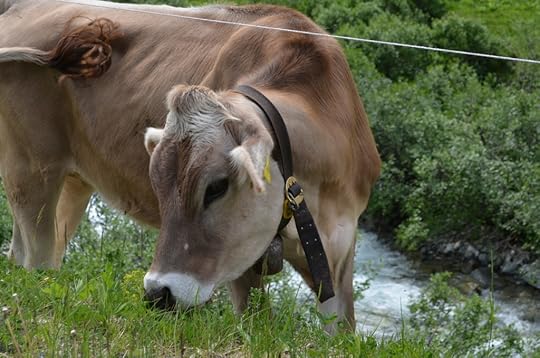
Look at that fur. You can see from the photo it looks like the hair on a child!

Not just in postcards or promotional videos. This is the real deal–the actual road. I snapped this as I turned around in the car to get “the view down the hill.”
This road had a scene between Kaitlyn and Rick, where he pulls over and asks they set aside their “convenient date” status to be something that’s special to this place and time in their lives.
The James Bond Dam
In actuality, this is called the Contra Dam, as well as the Verzasca or Locarno Dam, was made famous worldwide in Goldeneye when (as stunt man, standing in for) Pierce Brosnan bungee jumps over the edge, straight down, fires the gun, locks it, then penetrates the soviet stronghold. I’m telling you what: never in all my life have I seen a dam like this, and I’d thought the Hoover Dam outside Las Vegas was impressive. Not even close. Perhaps my long lens would have captured the magnificence a bit better, but my shorty had to do. The Dam gets a mention in several books, not just one.

Contra Dam–the best shot from the road looking up
St. Moritz
Now this town had its inspiration in my dad, who often spoke of going to St. Moritz (pronounced San, not Saint) when he was a young man, then later as he traveled for business. He’d speak of the town, the food and above all, the ability to get custom clothes and shoes made. It would be decades until I got to experience the town myself, and my that time, it had been so built up in my mind I wasn’t sure if it was going to meet expectations. Well, it exceeded all I’d imagined. The streets were/are still narrow yet uncrowded. The small shops with exquisitely made, half-million dollar watches next to an ounce of hazelnut chocolate for $15 francs and cashmere clothes that made me drool. I wrote about all these items in A Convenient Date, where the lead characters, Kaitlyn Reid and Rick Santos visit the small town for a conference.
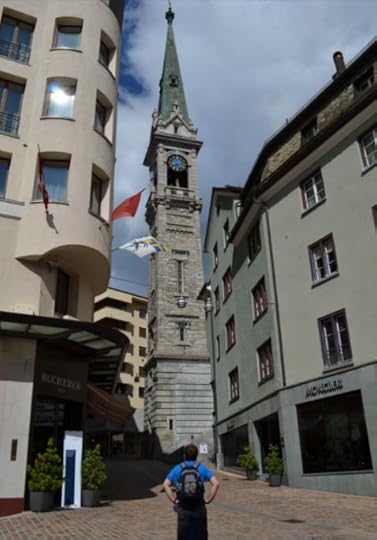
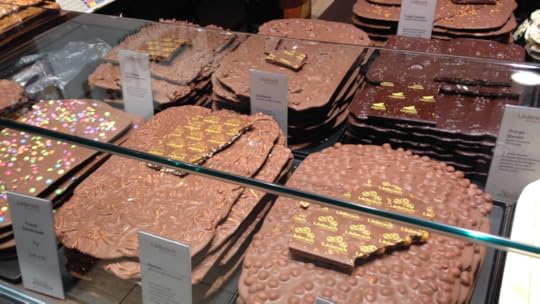
Everything is appropriately expensive in this lovely little town, from watches to chocolate. I purchased the chocolate:-
The gondola ride and the Russian Oligarch
Now this was fun and totally unexpected. In June, the snow is gone, but St. Moritz is still rather chilly. Rog and I had been discussing (aka arguing) about where to stop and eat, but it was sort-of between seasons (ski/winter and summer/tourist), which meant most of the places weren’t open. Undecided, we went to the gondola and took a ride. In we went, over the town and up mountain, getting the birds-eye view of the spectacular homes resembling fortresses on the mountain. At that moment, I visualized a scene with Lars and Danielle (back to Made for Me), riding the gondola, her asking him about the home, and him telling her it was the resident of a client, a Russian oligarch.

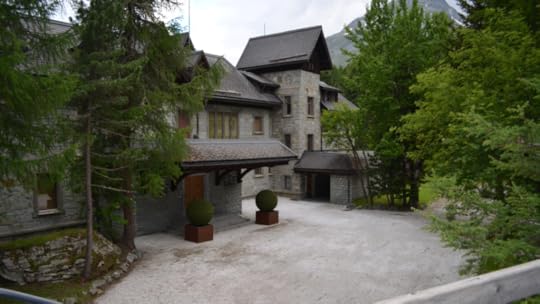
After the gondola ride, we were able to take the car and go directly up the roads. No gates, no security guards. I guess St. Moritz is so secure and area so safe, no one bothers with such piddly things.

By this time, I donned my coat (still in St. Moritz), but Rog is sporting shorts and a t-shirt like it’s warm.
The crossing in to Italy
You can imagine my depression when we slowed down at the border between Switzerland and Italy, thinking the Italian guards were at least going to check our passports. They barely looked up before waving us through. I was ready, passport in hand, when Roger looked at me some undiluted pity. “That’s the whole point of the Eurozone.” Duh. I moped, putting it away, feeling stupid, but still disappointed. I channeled this scene in to A Convenient Date, when Rick takes Kaitlyn for a drive to his childhood home on Lake Como. On the way, she remarks on the slate-topped homes of Italy, which were so very different from those in Switzerland.
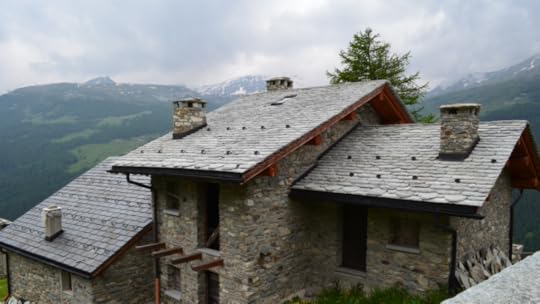
Slate, slate, slate….the change in materials once in Italy was dramatic and powerful
Feature image: the hills of the Alps, outside St. Moritz
Mayan Ruins: Coba, Tulum and Chitzen Itza
Tulum, Coba and Chitzen Itza are three different spots with famous ruins of the Mayan Culture. Having been to all three, I’m using this blog to point out the differences between the areas, with a specific focus on ease of the journey, what you can expect to see, and if the experience will be worth your time, particularly if you have a family. Because you have the jungle (Chitzen Itza) and the beach (Tulum) with Coba right in the middle, you have variety!
The highlights
Chitzen Itza is approximately three hours outside Cancun, a mostly straight drive which allows you to speed right along. The best time to go is either before the buses head out of town (roughly nine-am) or in the early afternoon, which guarantees you’ll miss the crowds. It’s uber hot and muggy in the jungle of Chitzen Itza, with zero breeze. The area is expansive with incredible structures and lots of history, but after an hour, my girls were ready to go. The colosseum-size area where gladiators fought to the death (and if you remained alive but lost, you were beheaded anyway), weren’t enough to keep their attention. Most importantly, four years ago, the government closed off the pyramids; no longer is one allowed to climb the famous structures. The first year, we’d scheduled the trip to see Rio Secreto and climb the pyramids, but only got one out of the two done. Still, the history and area is a must-see if you are in the Cancun area.
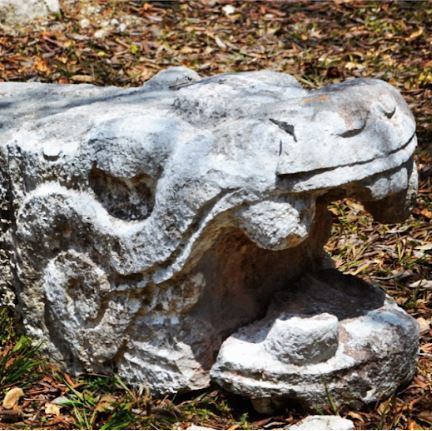
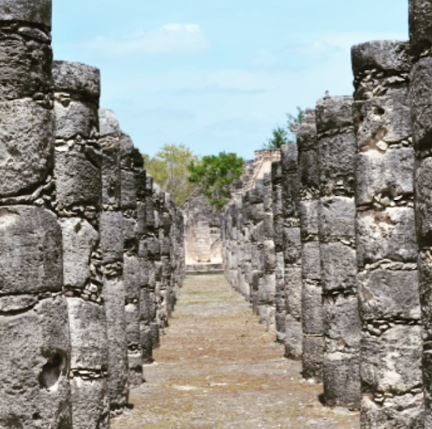
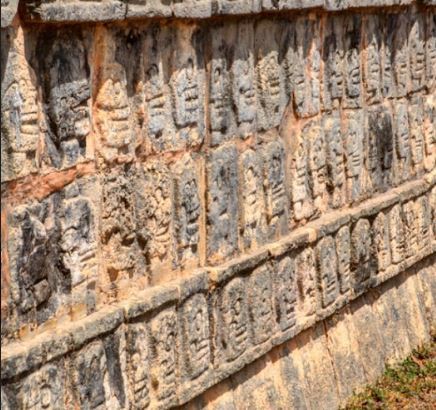
Taken at three different locations around the city: the upper left is in the marketplace, the columns are a part of the 1,000 that were created, and the bottom visual represent enemies that were killed by the Mayans.
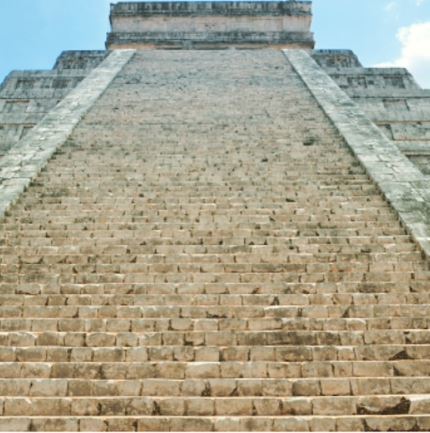
Since the government restricted climbing the pyramids, this is the next best thing. A view showing the incredibly steep climb.
Coba
Coba is the last pyramid in the Yucatan visitors can climb. It’s about two hours outside Cancun, offers great parking, and perhaps because it’s much smaller in terms of actual area covered, it’s about a 10th as crowded. We arrived late in the day, around 2 p.m., not realizing the entrance closed at 4 p.m. We paid the modest amount (about $7 US) and walked he 1.5 miles through the forest to the pyramid. Note that I call it a forest vs a jungle of Chitzen Itza. That’s because the jungle is hot, moist and dense, whereas in the area of Coba, the trees are sparse, the wood and type totally different and the air less humid. I pretty much suffered from heat stroke in Chitzen Itza, because I hadn’t eaten what I should have, nor did I drink as much water. At Coba, it was like being in Idaho, dry and arid. If you don’t want to walk, you can either rent a bike, or be transported (by bike) to the pyramid. The climb is a @400 steps up, and the view can’t be beat. It’s incredibly steep, with a rope to aid climbers—but the climb up isn’t that hard. It’s the way down that’s spooky. Be prepared—some of the steps are worn and slippery.



The drive to Coba was our favorite of the three. Long stretches of pavement with interesting sites along the way.

Yep, it’s as steep as it looks. You can tell the difference in building styles and structure from Chitzen Itza.
Tulum
Situated on the gold coast, the ruins of Tulum appear on about every photographer or traveler’s web site, so we were uber excited to go. Well….I just want to say this: the buildings are short and modest if you compare it to Chitzen Itza. That’s not to say the history isn’t fascinating, which it is, or that the architecture isn’t worthwhile! But for children 9 and 13, after seeing CI and Coba, Tulum was a total and complete let down (for them). As an adult, I found the historical tour fascinating, marveling at the engineering prowess of the Mayan’s, their ability to identify time, the setting and rising sun, building their structures to capture the exact time and place of both for specific rituals. All this was lost on our girls. However, the private beach which is open to the public did get their attention, so note to the visitors. You can swim in the area, but the park doesn’t offer showers or changing facilities, so if you go in the water, you’ll be sticky on the way back.

About the only picture I salvaged from Tulum!
Out of the three, what do I recommend to you, the person who may have only one day to travel?
Well, I must say you have to do all three, but the order is fully dependent on your personal preference. If you want to climb the only pyramid in North America which is available (outside Belize, which was seven hours away from Cancun, and that was just too far), then you MUST to Coba. Here’s the good news: it will take you less than four hours to drive, climb and leave, and there’s really nothing else for you to see down there. With that in mind, you can hit Tulum on the way back, and then you have hit both in one shot!
If Chitzen Itza is on your bucket list, then by all means, go the other direction. Sadly, my entire folder of shots got wiped out due to my lack of backup skills, so I can only offer a few I’d sent to my Instagram account.
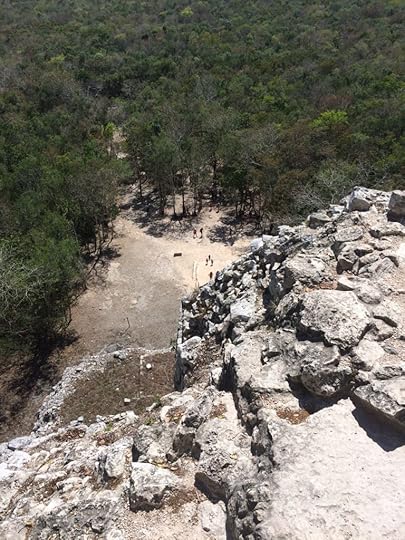
From the edge of the top, looking down. Definitely think twice if you are afraid of heights. We observed grown men having serious issues going down.
Safety and security
We’ve found that most of the tourists we run into are afraid to drive a car or get on a bus to most of these locations. I’ll admit my personal utility for hopping a bus is low—it extends the drive time immensely! But if you have a rental car, which we always get, we’ve never felt unsafe driving in and around Cancun. Local patrols are everywhere in the city, and once outside the limits, it’s mostly farmland, cattle, cenotes and little towns.
Feature image: taken with the wide angle iPhone from the top of Coba



